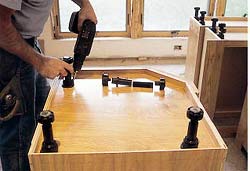Teamwork Versus Solo Work on the Shop Floor
Cabinetmakers discuss efficiency on the shop floor. When should people work in pairs, and when should handle tasks alone? June 23, 2014
Question (WOODWEB Member) :
I have a small shop with just two-three people working at any one time. Maybe because I started solo and got used to it, I tend to schedule people to work individually rather than as a team. For one thing, I believe that it is easier to spot problems with a single person pace than a faster grab and stack pace. Recently I have some employees that have worked in other shops and tend to want to slam out a stack of parts by working in pairs. For some things this might make sense, like the widebelt maybe. For lots of other scenarios it seems like one person is not doing much and the time doesn't net out to be an advantage (not half as long for twice the labor cost). Iím curious to hear what others are doing.
Forum Responses
(Business and Management Forum)
From contributor Y:
The obvious use of two people is for machines that can be fed continuously: widebelt, rip saw, bander without a return and the things that are large and easier to handle for two. There are some sequential operations where it helps to have a pair working together, one kind of sets the pace (the faster one) for the other.
From Contributor O:
I always went for an endless piece of lumber. That endless board going through the planer, sander, molder, etc. sounds, feels and is better. It drives me nuts to see someone stick a board in a machine, walk around, catch the board, go back and repeat. The endless board is much faster, better and makes the job go quicker - clockwise and mentally.
From the original questioner:
What really bugs me is when they pair up to run sticking, which we do after all the parts are cut and rails coped. One person can get the endless board pretty easily if they just approach it right, with a pause to shuffle a stack of parts. Or the moulder outfeed where the catch table is low enough to get five layers before you would need to pause and move them out of the way.
From contributor M:
The real challenge is to run an endless board through the planer when working by yourself. See how long you can last, and get a good cardiovascular workout while you are at it.
From contributor I:
There are two issues to manage. Efficiency is one. Some places have zero increase in output with a second person. Other places will have a 20% increase. Some others will have 110% increase.
Another issue is bottlenecking. If there is no bottleneck at this station, then one person is fine. Move the second person to your bottleneck. If there is a bottleneck at this station, then adding a second person is imperative. Even if the output is increased only 20% you are increasing the revenue of your entire business by 20%, and only cost is your lowest paid hourly person.
From Contributor O:
The real gain in productivity is important, of course. You need to set the example as attempting to get the endless board alone, but getting help if it will pay off. Common sense, but with that production mindset. I once worked with a guy that as soon as you started up the planer or wide belt, he was at the other end, with cart, ready to catch. As the last board came out, he went back to his solo job. So I learned pretty quickly that this was a good thing. Others caught on eventually. We never had to ask, we just were there.
My personal high point in my one man shop was profiling glass stops on a powerfeed shaper while ripping the molding strips off on the table saw! The shaper was continuous feed, and the saw was almost, with featherboards and holdowns. The two were right next to each other, so easy to access. Stick a piece into the shaper, take another one out the end, and then it went right into the saw. This has entitled me to be the old guy that stands around and says "when I did this, I did it twice as fast."
From the original questioner:
Oh no, I'm that old guy! Good point on bottlenecks. I think that I will try to break this down for my main guy so that he isn't having someone catch while he fiddles with each part before putting it through whatever machine. Get the batch organized as it is created so that you can just put it through without thinking.
From Contributor O:
One simple thing I teach is to have the catcher place the part so it is ready for the next operation. Sounds simple, but some folks just don't think about that next step. One old guy I worked with said he spent six years offbearing on a bandsaw learning this lesson - age 12 to 18.
